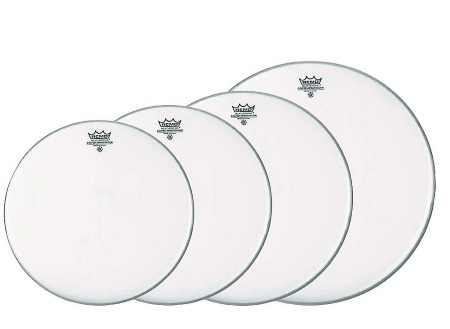Drum Head History
A quick look at the history of our drum skins
This is a small snippet looking at drum head history from my book: The Drum: A History
Early Evidence
The first drum head decomposed without a trace several thousand years ago. It is likely that it was a reptile or fish skin stretched over hollowed wood or even clay and may have been discovered by accident when drying a skin. A chance discovery of such a sound must surely have evoked great excitement and fascination, much as it still does today. Other skins were experimented with over time and larger animals were used to accommodate larger drums. Up until the middle ages, the skins were attached by way of the counter hoop and rope tensioning but this method was now being replaced by attaching the skin directly on to a separate flesh hoop.
 Production Method
Production Method
As time went by, the quality and preparation of the skin improved. Expert tanners evolved who could prepare these animal hides to produce high quality drum heads and in the nineteenth century firms appeared who could supply these in large quantities as well as producing other products such as book bindings, lampshades, and sporting equipment. The heads were often priced as untucked with an additional fee for the service of tucking the head. Some drummers chose to carry out this task themselves, especially today as it is a minority endeavour and many of the specialist companies have long since closed their doors. The task is quite laborious as decisions need to be made that will greatly affect the end product. First of all a hide needs to be selected. Factors such as age, location, climate, diet, colour, and quality of hide all affect the end result. The thickness of the selected hide may be determined by intended style of use; the thicker heads suiting reproduction of early music for example. A choice of animal must also be considered, with calf and goat being the two most common in Europe and North America. Once selected, the hides are soaked to loosen the hair and remove unwanted particles. They are then rinsed with water and the hair and flesh completely removed. At this point they are stretched and dried gradually, which increases durability. Once dried they are ready to be cut to size and this is always a few inches larger than the circumference of the drum, to leave enough skin for tucking around the flesh hoop.
The hide is now ready to be tucked, or lapped, on to the wooden flesh hoop. The skin is laid on a flat surface and the flesh hoop placed centrally upon it. By use of a blunt steel blade with an upturned end, known as a lapping tool, the skin is brought up from the outside, over the flesh hoop, around it and then tucked up underneath it, between the hoop and the hide. Once pushed up as far as it will go, it should be clamped in place whilst the procedure is repeated diametrically around the head ensuring even tension throughout. The skin is now ready to be placed upon the drum shell and the counter hoop applied before screwing in the tension rods. This is a process that many have neither the time nor the inclination to become involved with and to add to the inconvenience, throughout the mid twentieth century the price of calfskin heads was rising dramatically, which left the market open for a cheaper alternative.
Modern Drum Heads
The next stage in drum head history involved a company called Du Pont who had been testing the synthetic polyester film Mylar during the early 1940s and it soon began to be used commercially. Once found to be suitable for drum head, many people began to experiment with it and the result was the synthetic drum head we enjoy today. This opened the way for the likes of Remo and Evans who were first to latch on to this new technology.
This is a small snippet looking at drum head history from The Drum: A History so if you want to read in greater details then grab the book.
If you want to know how to tune your drum heads to get the best sound from your kit then you might like this comprehensive drum tuning course.
If you want to browse the drum lessons available at Total Drummer check out the free lessons, single lessons, mini courses and main courses.
You might also be interested in the drum less playalongs and the charts of famous songs.
Faster Hands in 7 Days FREE Drum Course
Improve your drum hand speed in a week to get Faster Hands
We all want faster hands on the drums but so many drummers I see are missing the basic aspects of drumming that will take them to the next level.
Many of those drummers are not lazy. In fact it’s the opposite. They are putting in the work but they are missing the fundamental techniques that will allow them to play faster and smoother. This leads to inevitable frustration and despondency.
In effect they are wasting their time!
By clicking below you can gain access to a FREE ‘7 days to faster hands’ drum course that will guarantee to raise your speed by the end or your money back (yes it is free so not the best guarantee ever!). But seriously, it will make a difference in a really short space of time.
But more than trying to create unrealistic miracles in a short space of time, it will also set up long term habits that will help you find your full potential as a drummer long into the future. And that is way more important.
It will show you:
- The fundamental techniques to play at your best level
- How to properly grip the sticks
- How to prepare yourself properly to drum
- How to make the stick do the work so you don’t have to
- How to set your drums up for optimum speed
- How to apply this around the kit
- Exercises to develop control as well as speed
- How to take this on into the future to become awesome!
And more than that you will also get a ton of other great free drum resources to make you a better drummer such as playalong tracks, articles, exclusive video lessons and more. And it’s all free!
Watch the video to get a feel for what the seven day course entails and then scroll down to get the course immediately.
Start today and build your hand speed up
So let’s start the course today. Do it now and begin your 7 day process to get faster hands. This time next week you’ll be enjoying the results and thinking about how you can take it to the next stage (by the way, the course helps with that too as we’ll be checking speed progress over the next 12 months).




